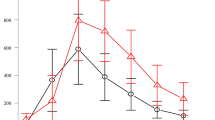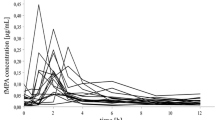Abstract
Profiling of absorption of cyclosporin microemulsion (Neoral®) is a concept in therapeutic drug monitoring (TDM) designed to further optimise the clinical benefits of this formulation in transplant recipients. A single blood concentration measurement 2 hours after Neoral® administration (C2) has been shown in both liver and kidney transplant recipients to be a significantly more accurate predictor of drug exposure than trough concentrations (C0), and its use results in a reduction in the incidence and severity of cellular rejection. In a prospective trial in de novo renal transplant recipients, patients who achieved target concentrations for area under the concentration-time curve over the first 4 hours postdose (AUC0−4h) of 4500 to 5500 ng · h/ml within 5 days of transplantation had a 7% incidence of histological acute rejection, compared with 37% rejection in those patients who did not achieve this target level. Of the single sampling points, C2 correlates best with AUC0-4h(r2 = 0.86); C0 had the poorest correlation. In an international study in 21 centres examining the absorption profiling, C2 samples were the most accurate predictors of AUC0–4h and freedom from rejection.
In liver transplant recipients receiving Neoral®-based maintenance immunosuppression, adoption of Neoral® C2 monitoring identifies patients who are both over- and under-dosed, which is not distinguished by C0 measurements. Further adjustment of C2 to recommended targets, even at 5 and 10 years after transplantation, results in reduction in nephrotoxicity without exposing the patient to the risk of rejection.
In summary, despite a level of simplicity comparable to C0 measurement, Neoral® absorption profiling, and specifically C2 measurement, is a much more sensitive approach to assessing the pharmacokinetics and predicting the clinical effect of this formulation in the individual patient, with a consequent marked reduction in the incidence of acute cellular rejection and improved long term graft function.












Similar content being viewed by others
References
Belitsky P, Levy GA, Johnston A. Neoral absorption profiling: an evolution in effectiveness. Transplant Proc 2000; 32Suppl. 3A: 45S–52S
Mahalati K, Belitsky P, Sketris I, et al. Neoral monitoring by simplified sparse sampling area under the concentration-time curve: its relationship to acute rejection and cyclosporin nephrotoxicity early after kidney transplantation. Transplantation 1999; 68: 55–62
Grant D, Kneteman N, Tchervenkov J, et al. Peak cyclosporine levels (Cmax) correlate with freedom from liver graft rejection: results of a prospective, randomized comparison of Neoral and Sandimmune for liver transplantation (NOF-8). Transplantation 1999; 67: 1133–7
Lindholm A, Kahan BD. Influence of cyclosporine pharmaco-kinetics, trough concentrations, and AUC monitoring on outcome after kidney transplantation. Clin Pharmacol Ther 1993; 54: 205–18
Schroeder TJ, Hariharan S, First MR. Variations in bioavailability of cyclosporine and relationship to clinical outcome in renal transplant subpopulations. Transplant Proc 1995; 27: 837–9
Johnston A, David OJ, Cooney GF. Pharmacokinetic validation of Neoral absorption profiling. Transplant Proc 2000; 32Suppl. 3A: 53S–56S
Belitsky P, Dunn S, Johnston A, et al. Impact of absorption profiling on efficacy and safety of cyclosporin therapy in transplant recipients. Clin Pharmacokinet 2000; 39: 117–25
Kahan BD. Cyclosporine. N Engl J Med 1989; 321: 1725–38
Kahan BD, Welsh M, Schoenberg L, et al. Variable oral absorption of cyclosporine. A biopharmaceutical risk factor for chronic renal allograft rejection. Transplantation 1996; 62: 599–606
Savoldi S, Maiorca R, Maderna M, et al. Low intra-patient variability of blood cyclosporine levels is correlated with excellent graft survival. Transplant Proc 1997; 29: 288–9
Johnston A, Sketris I, Marsden JT, et al. A limited sampling strategy for the measurement of cyclosporin AUC. Transplant Proc 1990; 22: 1345–6
Grevel J, Kahan BD. Abbreviated kinetic profiles in area-under-the-curve monitoring of cyclosporine therapy. Clin Chem 1991; 37: 1905–8
Amante AJ, Kahan BD. Abbreviated AUC strategy for monitoring cyclosporine microemulsion therapy in the immediate post-transplant period. Transplant Proc 1996; 28: 2162–3
Halloran PF, Helms LM, Kung L, et al. The temporal profile of calcineurin inhibition by cyclosporine in vivo. Transplantation 1999; 68: 1356–61
Sindhi R, LaVia MF, Paulling E. Stimulated response of peripheral lymphocytes may distinguish cyclosporine effect in renal transplant recipients receiving a cyclosporine+rapamycin regimen [abstract no. 12]. Transplantation 2000; 69: 432–6
Keown P, for the Canadian Neoral Renal Transplantation Study Group. Absorption profiling of cyclosporin microemulsion (Neoral) during the first two weeks after renal transplantation. Transplantation 2000. In press
Mahalati K, Belitsky P, West K, et al. Approaching the therapeutic window for cyclosporine in kidney transplantation: a prospective study. J Am Soc Nephrol 2001; 12: 828–33
Barama A, Perner F, Beauregard-Zollinger L, et al. for the Neoral Phase IV Study Group. Absorption profiling of cyclosporine therapy for de novo kidney transplantation: a prospective randomized study comparing sparse sampling to trough monitoring [abstract no. 190]. Transplantation 2000; 69 Suppl. S162
Levy GA, Lake JR, Beauregard-Zollinger L, et al. for the Neoral Phase IV Study Group. Improved clinical outcomes for liver transplant recipients using cyclosporine blood level monitoring based on two-hour post-dose levels [abstract no. 1059]. Transplantation 2000; 69 Suppl. S387
Levy GA. Neoral is superior to FK 506 in liver transplantation. Transplant Proc 1998; 30: 1812–5
Levy GA, O’Grady C, Lilly LB, et al. C-2 monitoring in liver transplantation with Neoral immunosuppression: effect of achieving C-2 target early on efficacy and safety [abstract no. 695]. Joint American Transplant Meeting; 2001 May 11–16: Chicago. Am J Transplant 2001; 1(51): 310
Levy GA, O’Grady C, Lilly LB, et al. Conversion to C-2 cyclosporine monitoring using Neoral immunosuppression in maintenance liver transplant patients: improvement in renal function and hypertension [abstract no. 694]. Joint American Transplant Meeting; 2001 May 11–16: Chicago. Am J Transplant 2001; 1(51): 310
Cole E, Cardella C, Cattran D, et al. Conversion of stable renal transplant recipients from cyclosporin microemulsion trough (C-0) to C-2 monitoring: implications for exposure [abstract no. 992]. Joint American Transplant Meeting; 2001 May 11–16: Chicago. Am J Transplant 2001; 1(51): 386
Author information
Authors and Affiliations
Corresponding author
Additional information
Use of trade names is for identification purposes only, and does not imply endorsement
Rights and permissions
About this article
Cite this article
Levy, G.A. C2 Monitoring Strategy for Optimising Cyclosporin Immunosuppression from the Neoral® Formulation. BioDrugs 15, 279–290 (2001). https://doi.org/10.2165/00063030-200115050-00001
Published:
Issue Date:
DOI: https://doi.org/10.2165/00063030-200115050-00001




